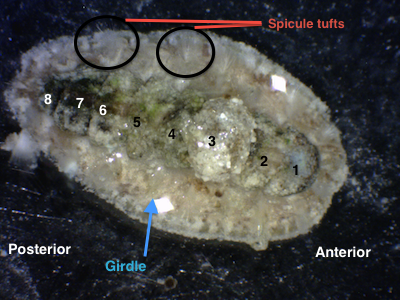Description
Dorsal side
Acanthochitona sp. is dorsoventrally flattened, with an elongate oval body and possess eight calcareous plates, known as valves. These valves have a reduced tegmentum (the visible area of the valves) due to the presence of a large fleshy girdle, which encompasses them. The edges of the tegmentum are rounded and the valves are sandy to green in colour, most likely due to the growth of algae. The girdle is fleshy; cream/sand coloured and covered in sand grains and other particulate matter (Figure 1). Thin, clear, spike-like calcareous spicules that look like they are made of silica can be found of the edge of the girdle, forming a spiculose fringe (Figure 2). This spicules also occur in 18 tufts on the dorsal side, running parallel on both the left and right side of the valves, in line with the suture (joint) of each valve (Figure 2). For a description of the valves, please see External Morphology.
 Figure 1: Acanthochitona sp. dorsal surface demonstrating the fleshy girdle with spicule tufts on the dorsal side that surrounds the eight valves. The valves are numbered 1-8 from the anterior (head valve) to the posterior (tail valve). Note that only the tegmentum of the plates are exposed and that plate three is covered by a build up of calcareous material.
Figure 2: The spiculose fringe on the edge of the girdle of Acanthochitona sp.
Figure 3: Close up of the posterior end (left) and middle (right) of Acanthochitona sp. with the blue arrows demonstrating the thin, clear, spicules on the girdle that occur at the valve sutures.
Ventral side
On the ventral side of Acanthochitona sp. is a cream-coloured broad, muscular foot used for locomotion and adhering to substrate that takes up the majority of the ventral surface. The anterior end of the foot has an inconspicuous head with the mouth located centrally. At the posterior end, there is a small anus and although not seen in the figure, two nephridiopores (for excretion) and two gonopores (to release gametes) occur laterally to the anus. These can be seen in the Respiration section. Around the periphery of the animal is the fleshy girdle, white in colour and quite broad. The edge of the girdle demonstrates a spiculose fringe as previously mentioned. A groove, known as the pallial groove separates the foot from the girdle and the gills occur in this groove. This groove is guarded by the pallial fold, which forms the pallial lappet at the posterior end of the foot, near the anus (Kaas et al. 1998).
Figure 4: Ventral surface morphology of Acanthochitona sp.
For a better understanding of the terminology used and to learn more about the characteristics of Acanthochitona sp., please see Identification Resources.
|